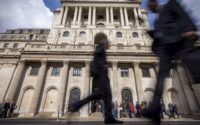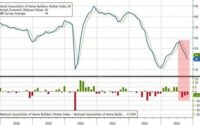- PCE index up 0.6% m-o-m in Jan after 0.2% rise in Dec
- Boeing slides on 787 Dreamliner jets temporary halt
- Adobe falls as DoJ to block Figma deal – report
- Indexes down: Dow 1.12%, S&P 1.28%, Nasdaq 1.94%
Wall St heads for big weekly drop as investors sweat rate hikes
February 24, 2023
Feb 24 (Reuters) – Wall Street’s main indexes tumbled on Friday, on course for their biggest weekly drop of 2023, as further strong consumer data had investors bracing for more aggressive rate hikes from the Federal Reserve to fight sticky inflation.
All three indexes were set for weekly declines of around 3%, with the blue-chip Dow Jones Industrial Average (.DJI) on track for its biggest weekly decline in five months.
After a strong performance in January, stocks have retreated this month as a slew of economic data amplified worries that the U.S. central bank might have to keep rates higher for longer.
Data on Friday showed the personal consumption expenditures (PCE) price index, the Fed’s preferred inflation gauge, shot up 0.6% last month after gaining just 0.2% in December. Consumer spending, which accounts for more than two-thirds of U.S. economic activity, jumped 1.8% last month, exceeding forecasts for a 1.3% rise.
Latest Updates
View 2 more stories
“The headline and core PCE numbers were well above expectations. What worries us most is that the data since the last Fed meeting has been extremely strong,” said Gene Goldman, chief investment officer at Cetera Investment Management.
“If the Fed had this data at the last meeting they probably would’ve raised by 50 bps and the tone from the press conference would’ve been a lot different.”
Traders of futures tied to the Fed’s policy rate added to bets of at least three more rate hikes this year, with the peak rate seen in the range of 5.25%-5.5% by June.
Cleveland Fed President Loretta Mester said the Fed should raise interest rates higher than necessary if need be to get inflation fully under control.
The S&P 500 slipped below its 50-day moving average of 3,980 points and, at one point, was threatening its 200-day moving average of 3,940 points. The Nasdaq Composite did slip below its 200-day level of 11,406 points, while the Dow dropped underneath its 100-day moving average of 32,937 points, having spent this week below its 50-day mark.
At 2.02 p.m. ET, the Dow (.DJI) fell 370.57 points, or 1.12%, to 32,783.34, the S&P 500 (.SPX) lost 51.16 points, or 1.28%, to 3,961.16 and the Nasdaq Composite (.IXIC) dropped 224.62 points, or 1.94%, to 11,365.78.
All 11 major S&P sectors fell, with technology (.SPLRCT) and consumer discretionary (.SPLRCD) among the biggest decliners. Communication services (.SPLRCL) fell 1.6%, on course for a sixth straight loss, its worst run since a similar six-session skid in August.
Megacap stocks including Tesla Inc (TSLA.O), Amazon.com Inc (AMZN.O) and Nvidia Corp (NVDA.O) slid in the range of 1.9% and 3.2% as Treasury yields rose.
The yield on two-year Treasury notes , which are highly sensitive to Fed policy, climbed to 4.826% – its highest in nearly four months.
Boeing Co (BA.N) slid 4.7% after the Federal Aviation Administration said the planemaker temporarily halted deliveries of its 787 Dreamliner jets.
Adobe Inc (ADBE.O) sank 7.6% on reports the U.S. Justice Department would block the Photoshop maker’s $20 billion bid for cloud-based designer platform Figma.
On the positive side, Beyond Meat Inc (BYND.O) surged 9.2% as the plant-based meat maker’s results indicated that its cost-control measures were finally bearing fruit.
Block Inc(SQ.N) gained 4.2% after offering an upbeat forecast for a key profit metric and noting it was slowing hiring to control costs this year.
Reporting by Johann M Cherian and Sruthi Shankar in Bengaluru and David French in New York; Additional reporting by Sinead Carew; Editing by Arun Koyyur, Sriraj Kalluvila and David Gregorio
Our Standards: The Thomson Reuters Trust Principles.
[ad_2]
Source link


